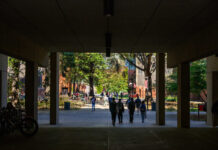UofL’s Climate Action Plan is in response to the American College & University Presidents’ Climate Commitment, an effort launched in 2006 to reduce the carbon footprints of higher education institutions across the country.
Released Sept. 15, the plan calls for UofL to trim its current output of just under 200,000 metric tons of greenhouse gas emissions a year to zero over the next four decades. The goal is to drop UofL’s emissions 20 percent by 2020 and 40 percent by 2030 before achieving carbon-neutral status by 2050, said Justin Mog, assistant to the provost for sustainability initiatives.
Using energy more efficiently, switching to renewable energy sources and helping students and employees find alternative transportation to and from campus are all key strategies for bringing about the reduction, he said.
With this plan, we are making the choice to step away from the familiar path and to chart a new course toward a clean, renewable future.
Persuading people at UofL to choose such modes of transportation as biking, walking and riding TARC buses will be critical to the plan’s success. Some 79 percent of employees and 65 percent of students now drive to campus, which accounts for 9 percent of the university’s carbon footprint, Mog said.
Behavioral change is going to be a big part of this, he said. We’re looking into things like installing energy monitor displays so people can see exactly how much power they’re using in their building, and creating new bike routes between campus and surrounding neighborhoods so people can bike to work more easily.
Mog and other members of UofL’s Sustainability Council began work on the plan in late 2009 after completing the university’s first greenhouse gas inventory. To establish a benchmark, they used data gathered by measuring power consumption in 115 buildings on UofL’s three campuses and other sources of carbon emissions such as vehicles.
We had to know how much carbon we were releasing and where it was coming from before we could figure out ways to reduce it, Mog said.
The university’s administration strongly endorses the goals and principles in the report, said UofL Provost Shirley Willihnganz.
We’ve already made great strides in reducing our carbon footprint and we hope to quickly implement some of the report’s recommendations, she said. Other recommendations will depend on funding and a full vetting by our university family.
UofL already is working on a variety of fronts to become more sustainable, Mog said.
Three UofL buildings earned a gold LEED (Leadership in Energy and Environmental Design) rating from the U.S. Green Building Council in the past year, and the university expects to save up to $30 million in energy costs by 2024 through an energy-saving partnership with Siemens Industry Inc.’s Building Technologies Division.
UofL also has reclaimed hundreds of acres of brownfields, is practicing single-stream recycling and green purchasing, and encourages students and employees to eat more local food through a farmer’s market, student-operated campus organic garden and Community Supported Agriculture program.
UofL President James Ramsey signed the President’s Climate Commitment in 2008.


























